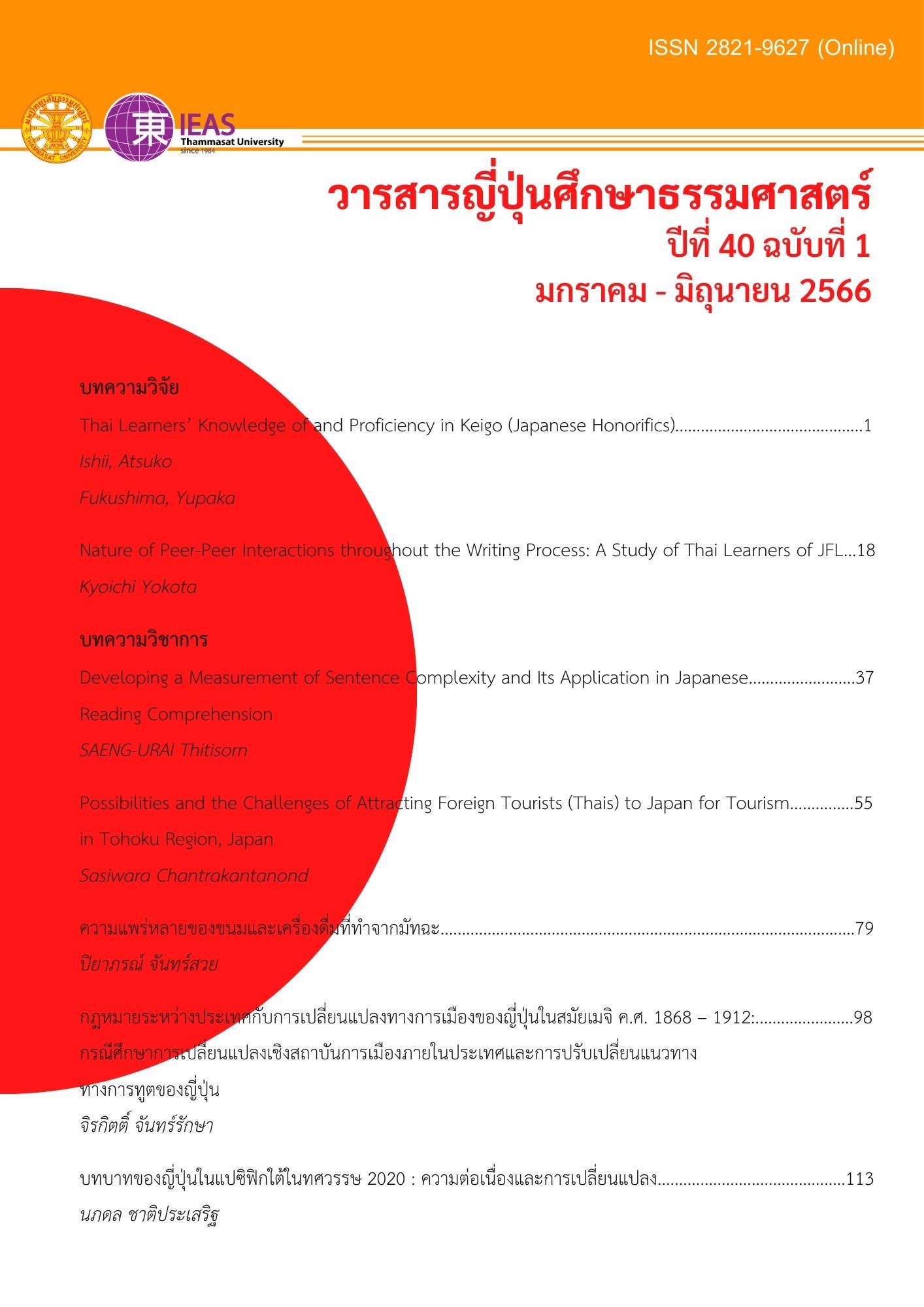Thai Learners’ Knowledge of and Proficiency in Keigo (Japanese Honorifics)
Keywords:
Keigo (Japanese honorifics), respectful form, humble form, misuseAbstract
Native Japanese speakers are expected to use keigo (Japanese honorifics), following Japanese grammatical rules and cultural etiquette, which are key factors through which they communicate. Keigo demonstrates respect, as outlined in “Keigo no shishin” (“Guidelines on honorifics”; Bunkashingikaitoshin, 2007). In addition, “Keigo no shishin” discusses that in Japanese, according to one’s feelings or thoughts, keigo might be chosen and used as a tool of self-expression. Therefore, this research investigates Thai learners’ knowledge of and proficiency in Japanese honorific expressions. Research participants were 18 third-year and 17 fourth-year Thai university students. For the study, they completed two tests, one of which comprises 23 multiple-choice questions to estimate their knowledge of Japanese keigo. In the other test, six short-answer questions on selecting politeness levels (1 or 2) estimated their proficiency in Japanese. A t-test on both results indicated no significant differences. Furthermore, the multiple-choice results revealed participants’ knowledge of Japanese to be poor or shallow; the most frequent errors in keigo occurred in grammatical form rather than in misuse of the respectful or humble form. The short-answer test also revealed a high percentage of grammatical misuse. In other words, the percentage of accurate or acceptable answers was low, implying that participants’ overall proficiency in Japanese was poor. Thus, Thai learners of Japanese cannot express themselves well or accurately due to low proficiency, often demonstrated in misuse of keigo.
Downloads
References
Mingkwan, T. (2009). Understanding and Attitude Concerning Japanese Honorific and Humble Expressions among Post-Basic Thai Learners [Master’s thesis]. Thammasat University. https://digital.library.tu.ac.th/tu_dc/frontend/Info/item/dc:124386
Poonvongprasert, T. (2016). An Error Analysis of Using Honorific Expression Among Japanese Language Thai Learners. Payap University Journal, 26(2), 33-54.
井口樹生. (1988). 「自己採点式あなたの敬語力をテストする」. 『国文学 : 解釈と教材の研究』, 33(15), 188-195.
井上史雄. (1999). 『敬語はこわくない 最新用例と基礎知識』. 講談社現代新書.
小川誉子美. (2005). 「日本語教育における待遇表現指導の現状と課題-学習者が遭遇する問題-」. 『日本語学』, 24(11), 76-85.
国立国語研究所. (1990). 『敬語教育の基本問題(上)』. 大蔵省印刷局.
菊地康人. (1996). 『敬語再入門』. 丸善.
坂本元太郎. (1977). 「敬語とその周辺」. 『北海道武蔵野女子大学紀要』, 9, 1-32.
坂本恵. (2012). 「『敬語コミュニケーション』教育の試み」. 『早稲田日本語研究学』, 11, 21-35.
原田大樹. (2017). 「小学校・中学校国語化における敬語指導教材―教材における「敬語」を中心にー」. 『福岡女学院大学紀要』, 8, 77-84.
文化審議会答申 . (2007). 『敬語の指針』.
村尾恵一. (2013). 「日本語リテラシー教育としての敬語:日本語学習者への実践を通して」. 『人文学論叢 / 愛媛大学人文学会』, 15, 149-160.
柳村裕. (2017). 「話者の職業による敬語使用の差異と変化: 岡崎敬語調査資料の分析」. 『国立国語研究所論集』, 12, 205-225.
Downloads
Published
Issue
Section
License
Copyright (c) 2023 Thammasat Journal of Japanese Studies

This work is licensed under a Creative Commons Attribution-NonCommercial-NoDerivatives 4.0 International License.




